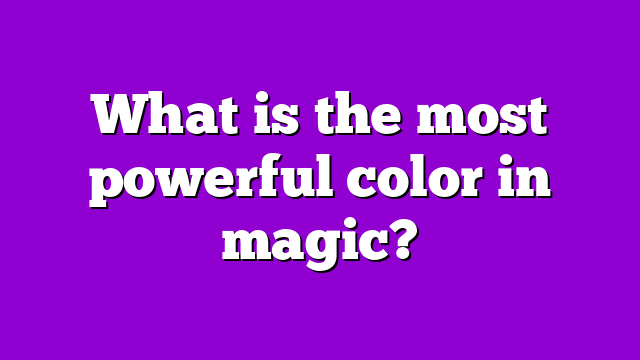Crystal Symbolism & Spirituality
What is the most powerful color in magic?
The most powerful color in magic is subjective and can vary depending on the intention and desired outcome. However, many practitioners believe that the color red is the most powerful because it is associated with passion, energy, and intensity. Red is often used in love spells, protection spells, and spells that require a burst of energy or motivation.
If you’re looking to increase serotonin levels, there are several colors that can help. Serotonin is often called the “feel-good” neurotransmitter because it is associated with feelings of happiness, relaxation, and well-being.
Here are some colors that can help increase serotonin levels:
• Blue: Blue is a calming color that is often associated with relaxation and serenity. It can help reduce stress and anxiety, which can increase serotonin levels.
• Green: Green is a soothing color that is associated with nature and growth. It can help promote feelings of harmony and balance, which can increase serotonin levels.
• Yellow: Yellow is a bright and cheerful color that is associated with happiness and joy. It can help boost mood and energy levels, which can increase serotonin levels.
• Pink: Pink is a gentle and nurturing color that is associated with love and compassion. It can help promote feelings of comfort and security, which can increase serotonin levels.
• Purple: Purple is a mystical and spiritual color that is associated with creativity and imagination. It can help stimulate the mind and promote feelings of inspiration and well-being, which can increase serotonin levels.
Incorporating these colors into your daily life through clothing, home decor, or meditation can potentially boost serotonin levels naturally.
Table Of Contents
- 1 The Power of Color in Magic: Understanding the Basics
- 2 Unlocking the Secrets of the Most Powerful Color in Magic
- 3 How Colors Affect Our Brain Chemistry
- 4 Serotonin: The Feel-Good Hormone and Its Connection to Color
- 5 Using Colors to Increase Serotonin Levels Naturally
- 6 The Role of Color Therapy in Boosting Mental Health and Well-Being
The Power of Color in Magic: Understanding the Basics
Color has always held a significant place in the world of magic. Each color has its own vibrational frequency that can influence energy, emotions, and the subconscious mind. Colors have been known to hold symbolic meanings across different cultures, such as red representing passion and love, while blue represents calmness and serenity. Each color has its own unique attributes that can be tapped into for different purposes, such as healing, meditation, and protection.
Whether it’s candles, crystals, or clothing, incorporating colors in your magical practice can amplify your intentions and manifest your desires. As color and magic go hand in hand, it’s essential to know which colors hold the most power and how they can be used for different purposes.
Unlocking the Secrets of the Most Powerful Color in Magic
Without a doubt, the color black is widely considered the most potent color in magic. Black represents the mystery and unknowingness of the universe, and as such is often used for protection, banishing negative energy, and repelling evil spirits. Black is frequently used in rituals involving the invocation of darker energies or entities, such as during a Samhain ritual, which is the witch’s New Year.
In addition to its protective qualities, black can be used to enhance the manifestation of certain desires, such as career advancement or better health. Combining black with other colors can amplify the energy of the spell. For instance, using black and green in a prosperity ritual can bring good luck and financial abundance.
How Colors Affect Our Brain Chemistry
Colors also have a direct impact on our brain chemistry, influencing our emotions, moods, and even appetite. For instance, red can stimulate appetite and enhance energy levels, making it a popular choice for restaurants. On the other hand, blue is known for its calming and tranquilizing effects, making it a favored choice for spas and meditation rooms.
Research has shown that colors can evoke different neurochemical responses in our brains, affecting the production of hormones such as serotonin, dopamine, and cortisol. For this reason, understanding which colors can boost our mood and mental health is important.
Serotonin: The Feel-Good Hormone and Its Connection to Color
Serotonin is a neurotransmitter known for its ability to regulate mood, sleep, and appetite. Low levels of serotonin are often associated with depression, anxiety, and other mood disorders. Therefore, naturally increasing serotonin levels can help improve overall mental health and well-being.
Many colors can help increase serotonin levels, with yellow being a popular choice. Yellow represents warmth, happiness, and optimism, and can help enhance feelings of joy and contentment. Another color that can increase serotonin levels is green, which symbolizes growth and renewal, increasing feelings of harmony and balance.
Using Colors to Increase Serotonin Levels Naturally
While color therapy isn’t a substitute for professional treatment, it can be a useful tool in promoting mental health and well-being. Here are some ways you can use colors to increase serotonin levels:
- Add yellow accents to your home or office decor, such as throw pillows or paintings
- Surround yourself with greenery or spend time in nature
- Meditate with a yellow or green candle
- Wear clothing in shades of yellow or green
The Role of Color Therapy in Boosting Mental Health and Well-Being
Color therapy has been used for centuries to promote healing and well-being across different cultures. By understanding the power of color, we can tap into its energy to promote total mind-body balance. Whether you’re dealing with stress, anxiety, or depression, incorporating color therapy into your routine can be a powerful tool.
Remember, color is not only visually stimulating but has the ability to shift our emotions and mental state. By incorporating colors into your daily life, you can tap into their unique attributes and energizing properties, promoting creativity, joy, and overall well-being.

